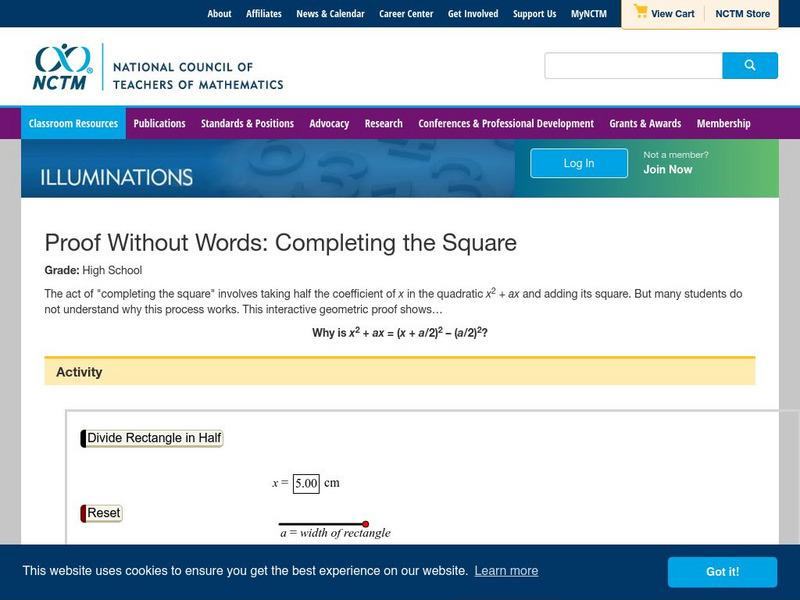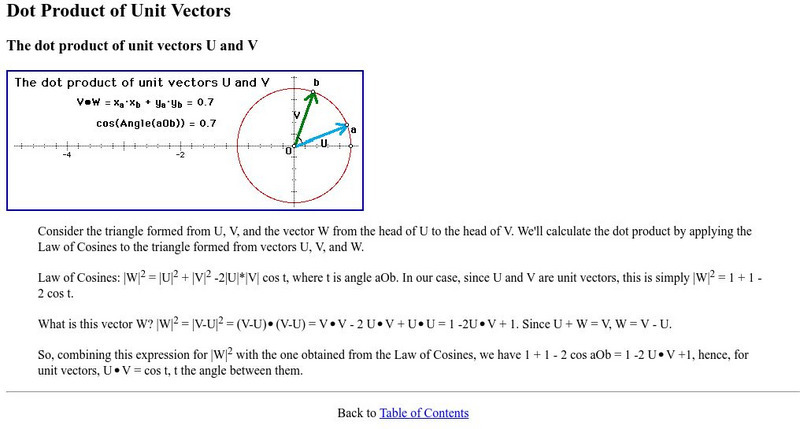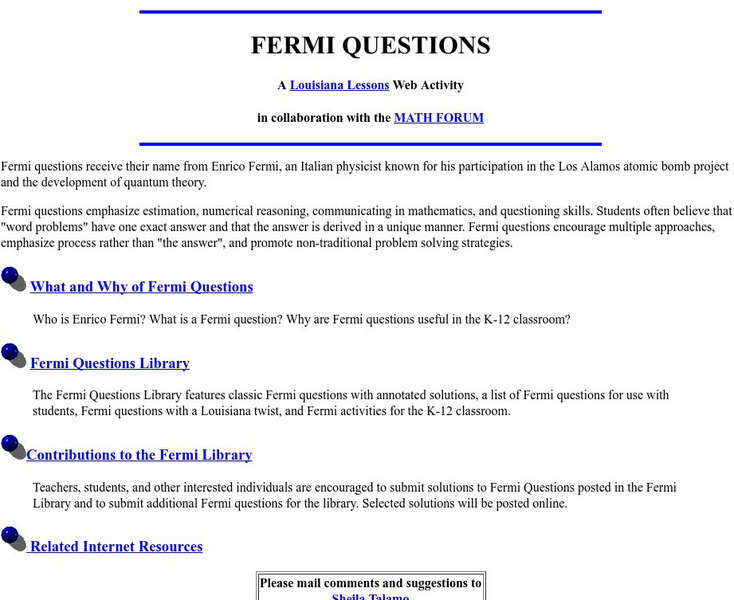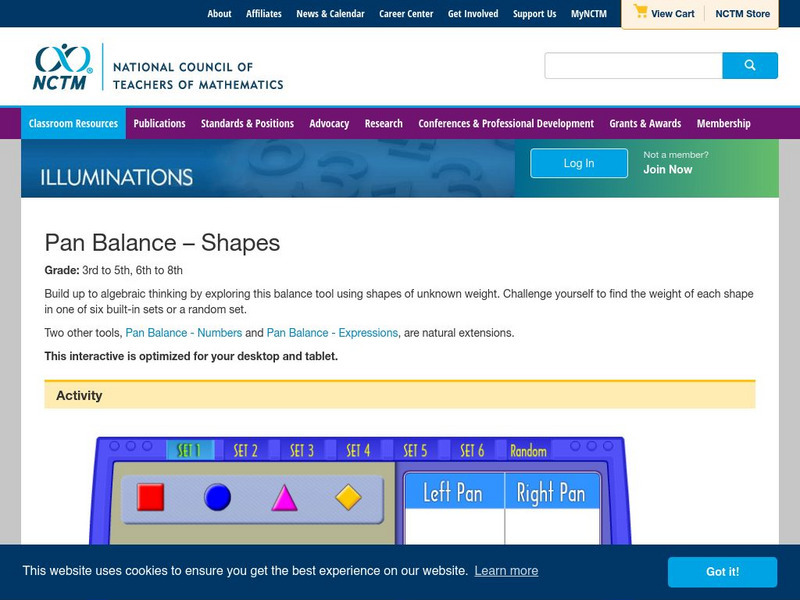National Council of Teachers of Mathematics
Nctm: Figure This: Beating Heart
Do you know how long it takes your heart to beat 100 times? Test your estimation and number sense skills with this problem-solving challenge. A one-page activity taken from the NCTM Math Challenges for Families Collection. Hints and...
National Council of Teachers of Mathematics
Nctm: Figure This: Line Up!
Take the math challenge. Can you figure out how long you have to wait in line to buy a ticket? An estimation and time measurement challenge from the NCTM Math Challenges for Families collection. Based on real-world themes and...
National Council of Teachers of Mathematics
Nctm: Illuminations: Scale Factor
The interactive applet allows learners to explore the relationships between side length, area, and perimeter. Students see how changes in the scale factor influence the ratio of areas and perimeters. [Requires Java.]
National Council of Teachers of Mathematics
Nctm: Illuminations: Proof Without Words Completing the Square
Students use this computer applet to visualize the concept of completing the square.
National Council of Teachers of Mathematics
Nctm: Illuminations: Linear Regression 1
An interactive program where students will explore regression lines. Students will be introduced to the correlation coefficient and come to understand what it represents through the given exploration. Requires Java.
National Council of Teachers of Mathematics
Nctm: Illuminations: Mirror Tool
This interactive tool helps student visualize symmetry. The exploration provided by the site helps students explore reflective symmetry. [Requires Java.]
National Council of Teachers of Mathematics
The Math Forum: Dot Product of Unit Vectors
This site gives an example of a problem showing how to find the dot product of unit vectors.
National Council of Teachers of Mathematics
Nctm: Illuminations: Circle Area
Explore what the relationship the radius has to the area of a circle. Click the instructions to learn how to use this interactive resource and select"Exploration" for more ideas.
National Council of Teachers of Mathematics
Nctm: Figure This: Does Drinking Soda Affect Your Health?
Try this "Real world," challenge taken directly from the today's health journals. Use your problem solving, data analysis, and number sense skills to figure out if soda intake among teenage girls is related to incidences of broken bones....
National Council of Teachers of Mathematics
The Math Forum: Fermi Questions
This tutorial from the Math Forum provides the approach to problem solving made famous by Enrico Fermi. Fermi, a brilliant Italian physicist, used estimation frequently in problem-solving.
National Council of Teachers of Mathematics
The Math Forum: Ask Dr. Math: Pascal's Triangle and Binomial Expansions
This Math Forum author shows how combinations can be used to identify the pattern in Pascal's Triangle.
National Council of Teachers of Mathematics
The Math Forum: Ask Dr. Math: 3 D Distance
"Ask Dr. Math" is posed with a question of finding the distance between a point and line in space. Read about the solution.
National Council of Teachers of Mathematics
The Math Forum: Ask Dr. Math: Long Division of Polynomials
This site is a help letter from a student asking how to divide polynomials. The response to this e-mail also discusses factoring as a method for doing the division.
National Council of Teachers of Mathematics
The Math Forum: Ask Dr. Math: Solving a Ratio With & Without a Diagram
A student is searching for a solution to a ratio question without using a diagram. Dr. Math helps to break it down both with and without a diagram. An understanding of fractions, multiplication, and basic algebra is necessary to get this...
National Council of Teachers of Mathematics
Nctm: Illuminations: Pan Balance
A pan balance helps students visualize what value for x will make two expressions equivalent. The computer applet graphs the lines and shows the intersection point.
National Council of Teachers of Mathematics
Nctm: Illuminations: Geometric Solids
The instructional tool explores various geometric solids and their properties. Student can manipulate and color the different shapes. Learners examine the edges, faces, and vertices of the different solid figures.
National Council of Teachers of Mathematics
Nctm: Illuminations: Pan Balance Shapes
Use this virtual, double pan balance and explore what shapes and amounts of shape balance each other. Great introduction to beginning algebra concepts.
National Council of Teachers of Mathematics
Nctm: Illuminations: Volume of a Cube
"The volume of a cube can be developed by considering unit cubes, a single row (longs) of unit cubes or a single layer (flats) of cubes using this applet." This easy software makes it possible to easily construct a cube and take it...
National Council of Teachers of Mathematics
Nctm: Illuminations: Mars Earth Orbit Computer Activity
Students will use this applet to form and test hypothesis of what the orbit of Mars will look like relative to Earth. [Requires Java.]
National Council of Teachers of Mathematics
Nctm: Illuminations: Shape Cutter
This computer tool allows students to compose and decompose shapes by making cuts and rearranging the pieces. The tool has an exploration section for learning exercises.
National Council of Teachers of Mathematics
The Math Forum: Ask Dr. Math: Learning Multiplication Facts
There are the usual, and some unique, tricks and games to learn and remember the multiplication tables at this site.
National Council of Teachers of Mathematics
The Math Forum: Ask Dr. Math: Compound Inequalities
"Dr. Math" provides a visual (graphical) approach to solving compound inequalities as opposed to an approach dependent upon algebraic manipulation.
National Council of Teachers of Mathematics
The Math Forum: Ask Dr. Math: Degree of a Polynomial
Answer to a question about how to find the degree of a polynomial. The question involves the degree when one of the exponents is negative, as well as a polynomial of two variables.
National Council of Teachers of Mathematics
The Math Forum: Ask Dr. Math: Synthetic Division
This Math Forum site describes a general method for synthetic division by comparing it to the long division process.

























